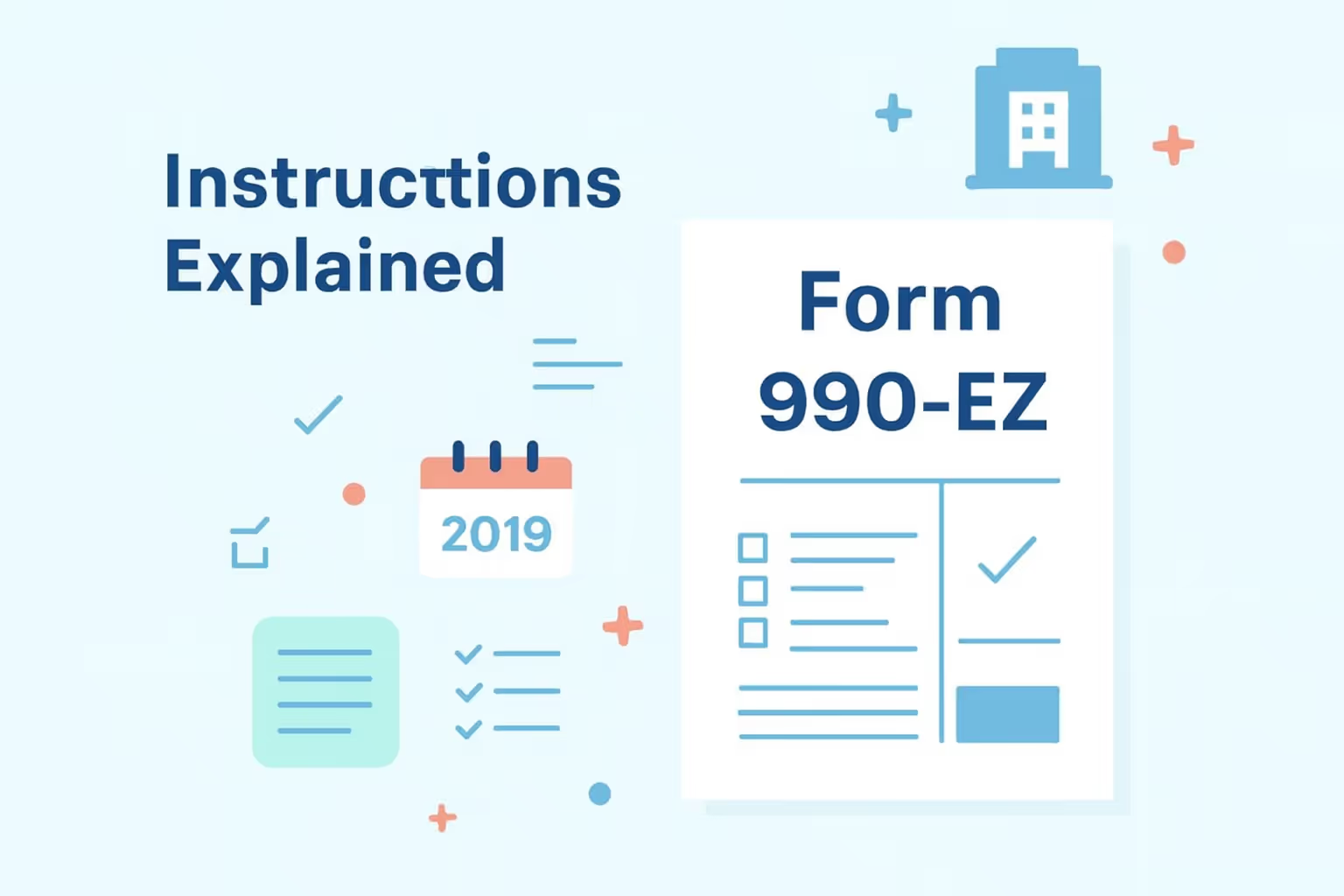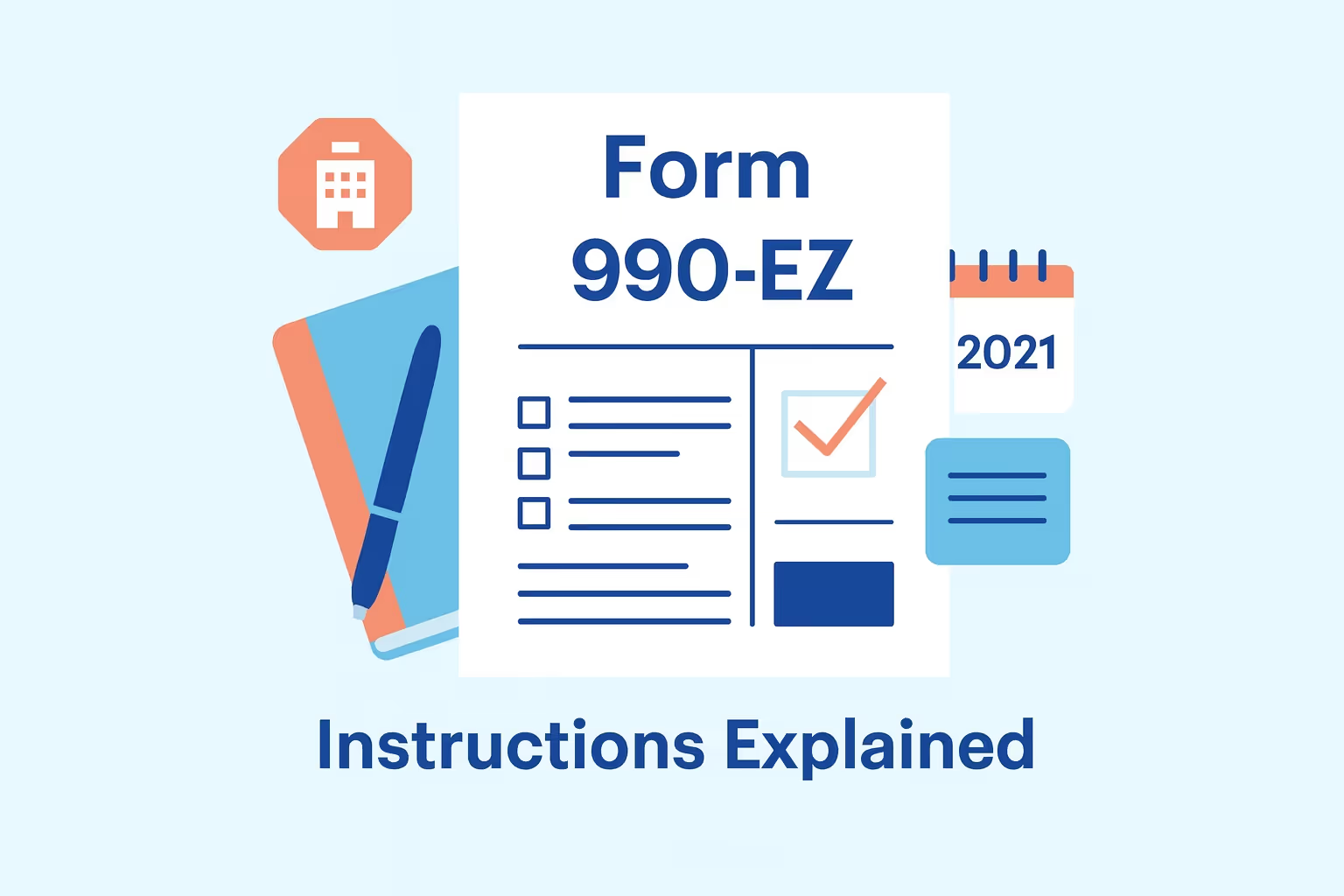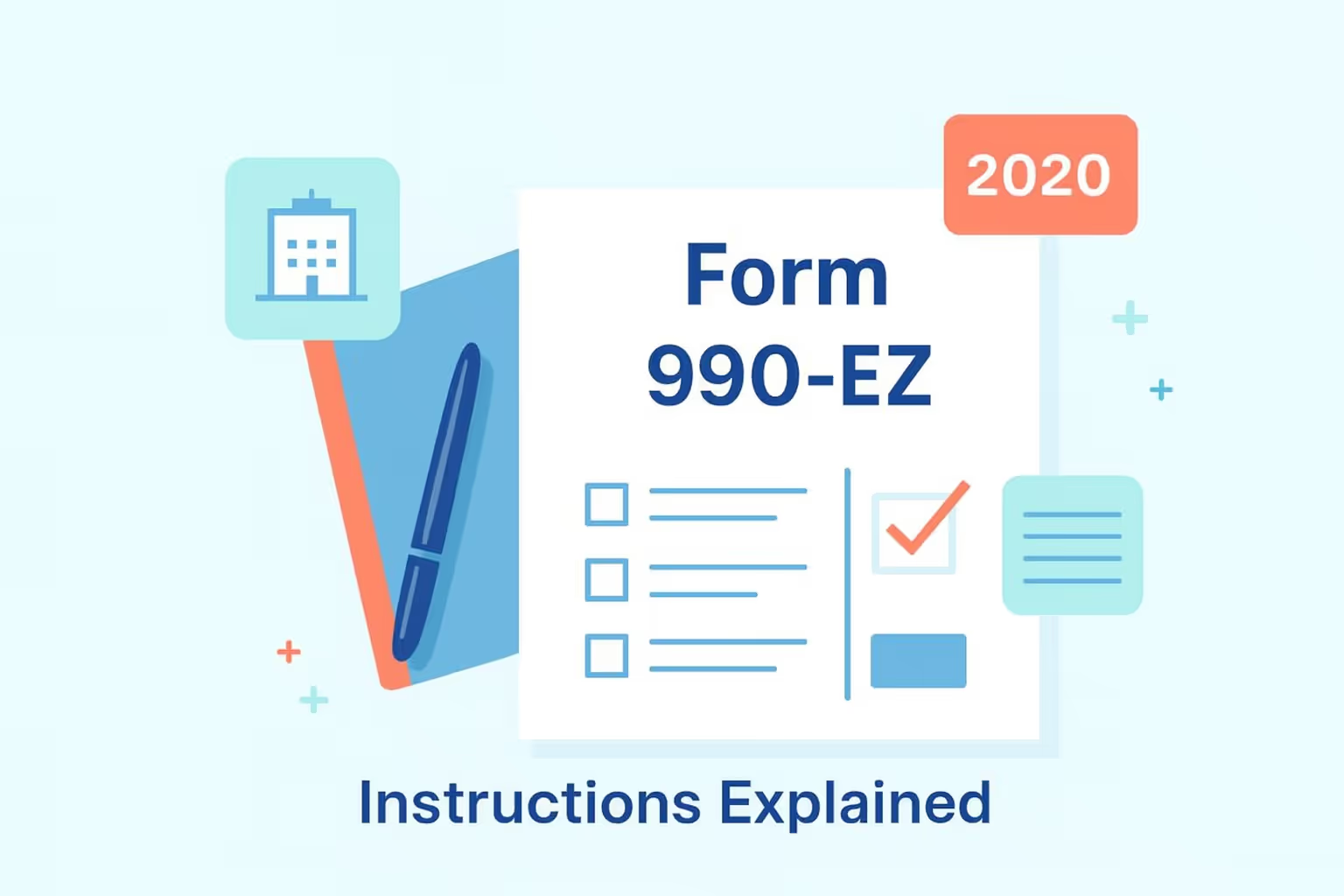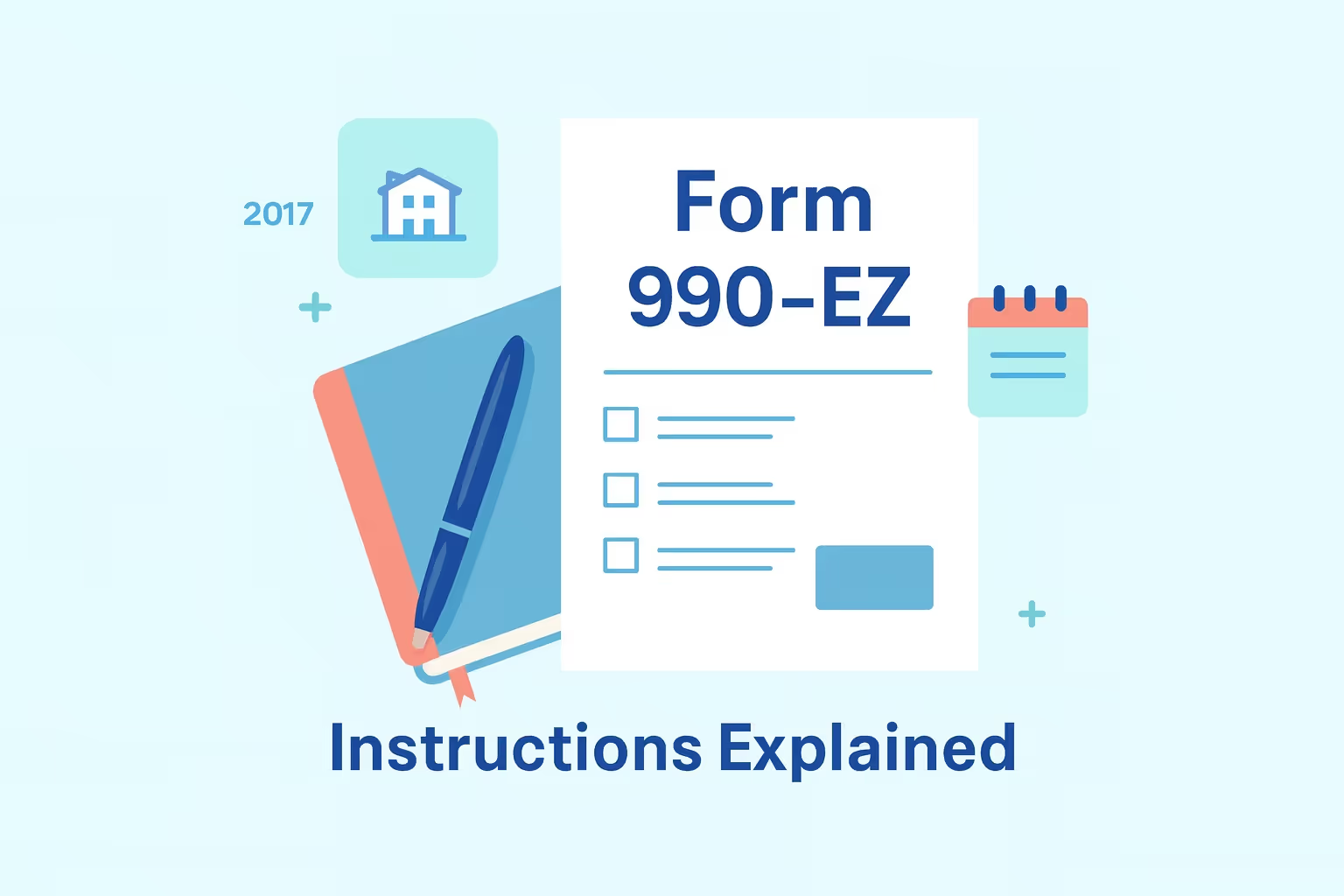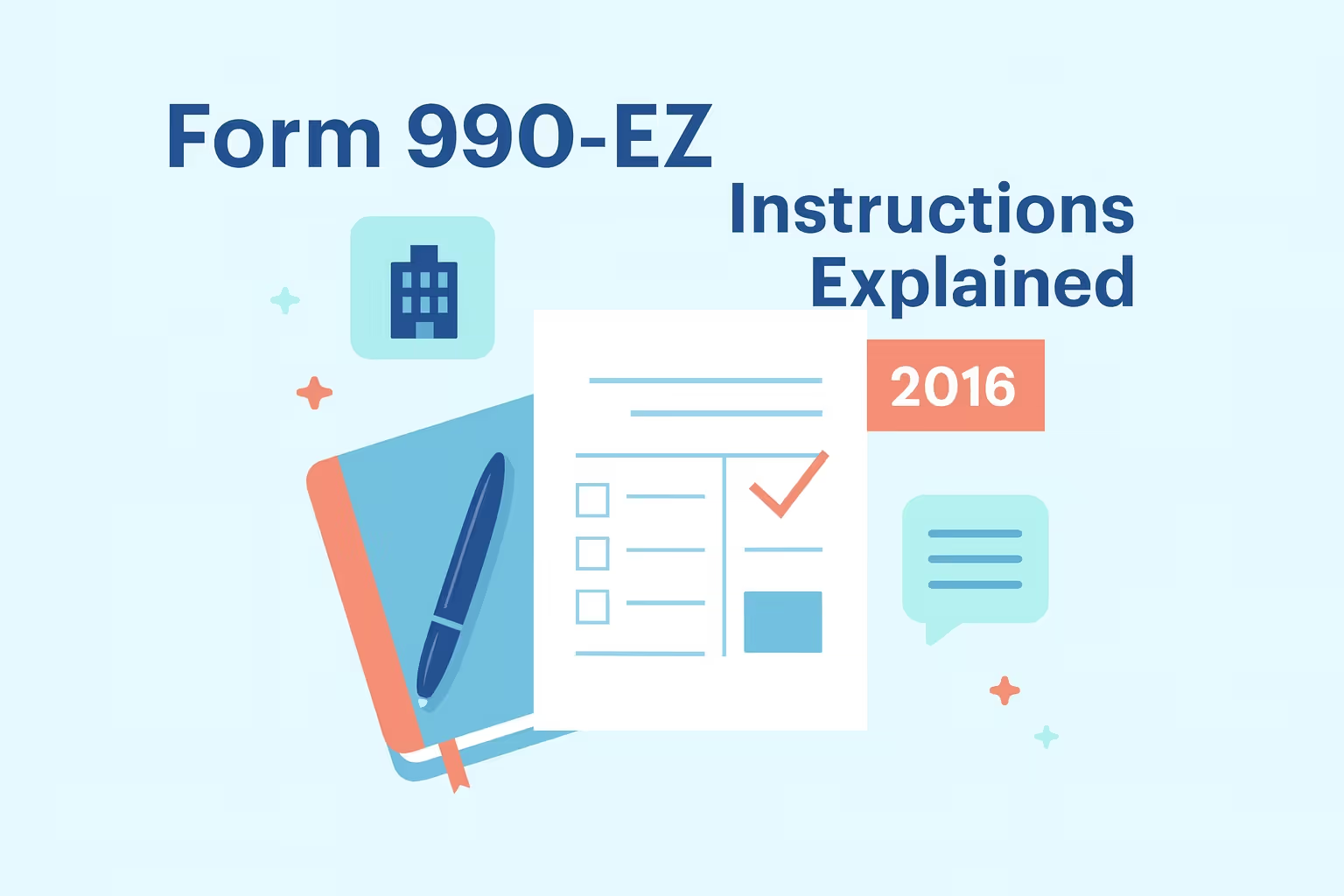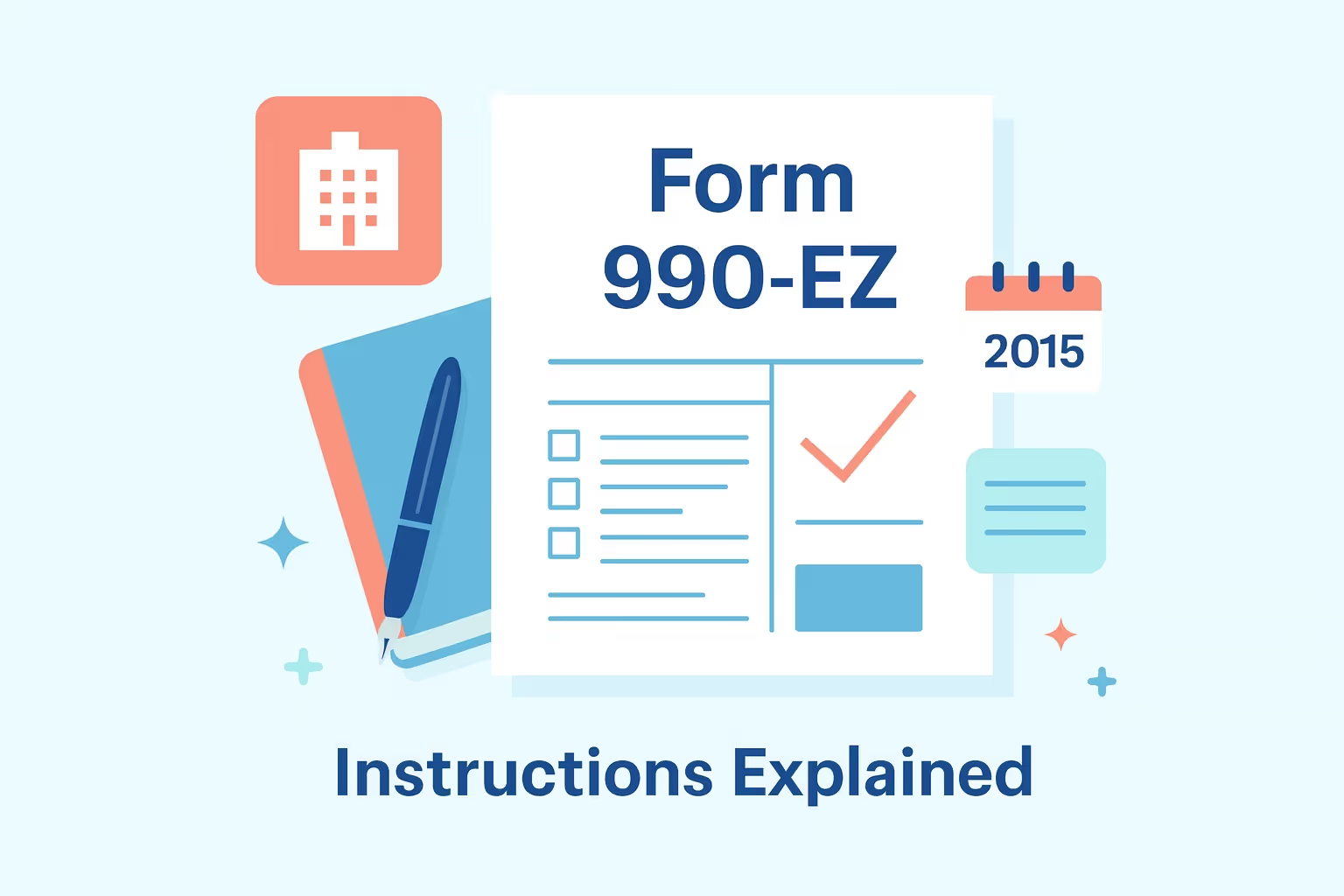Instrucciones del formulario 990-EZ 2018: Guía para grupos exentos de impuestos
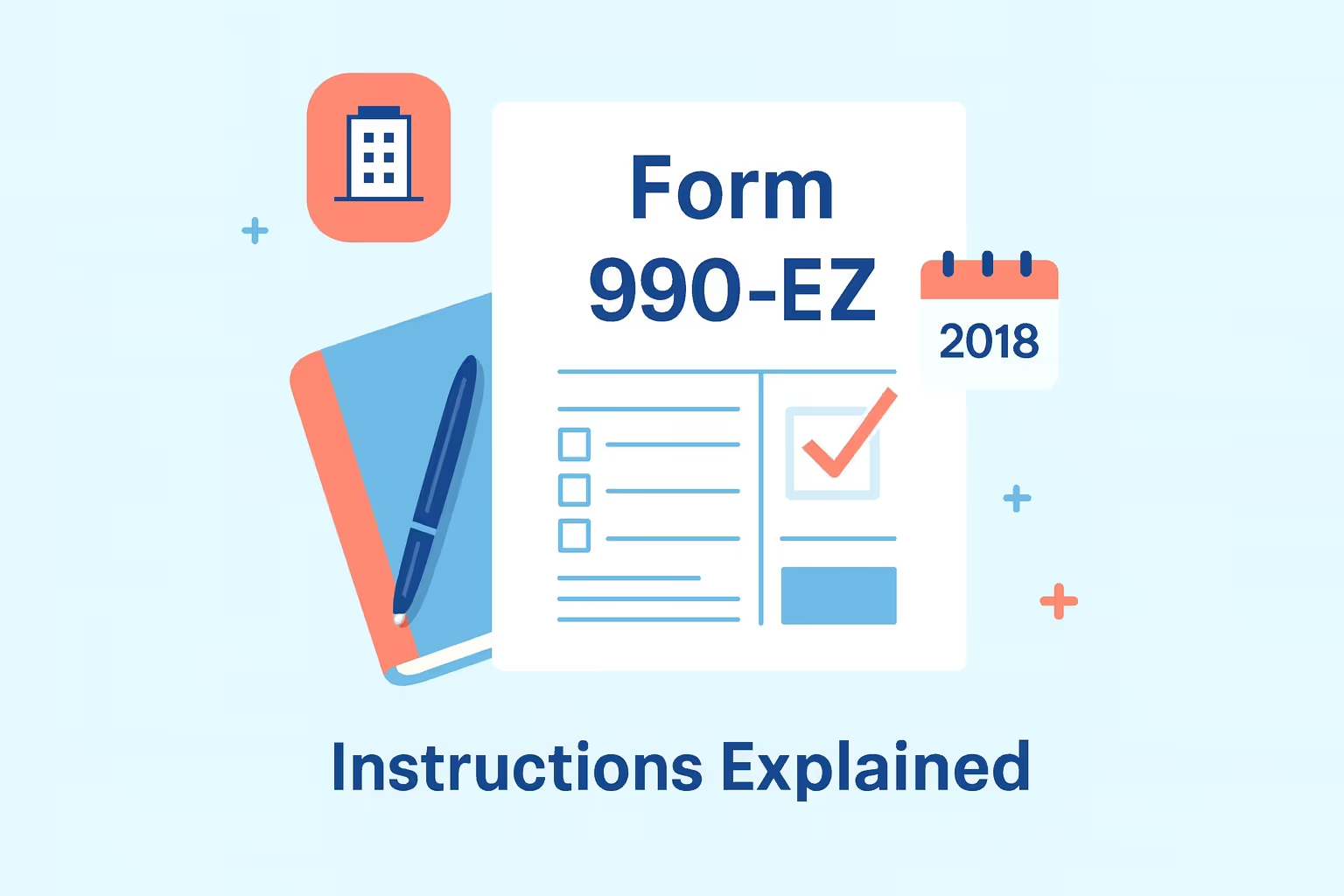
Presentar la declaración informativa adecuada es una de las responsabilidades más importantes de una organización exenta de impuestos. Para muchas organizaciones sin fines de lucro, el Servicio de Impuestos Internos creó el formulario 990-EZ como un método de presentación simplificado para las organizaciones con ingresos y activos anuales más pequeños. Esta guía se centra en la versión de 2018 del formulario y describe quién debe presentarlo, qué información se requiere y cómo el cumplimiento ayuda a mantener la exención de impuestos en virtud del Código de Impuestos Internos.
Las organizaciones sin fines de lucro utilizan el formulario 990-EZ para divulgar las contribuciones caritativas, declarar la compensación de los ejecutivos y compartir la misión de su organización con el gobierno y el público. Estas declaraciones de impuestos garantizan la transparencia, lo que permite a la comunidad evaluar cómo se administran las contribuciones. Para muchos grupos, incluidas las iglesias, las organizaciones benéficas educativas y las pequeñas corporaciones, el formulario logra un equilibrio entre la accesibilidad y la responsabilidad. El Instrucciones del IRS para 2018 para este formulario, establezca la línea de base para la elegibilidad, los requisitos de presentación y los estándares de presentación de informes.
Las entidades exentas de impuestos que siguen cumpliendo con las obligaciones del Formulario 990-EZ generan confianza entre los donantes, los donantes y las agencias de seguridad pública que dependen del apoyo de las organizaciones sin fines de lucro. Al recopilar cuidadosamente los registros y preparar declaraciones de impuestos precisas, las organizaciones fortalecen su credibilidad y, al mismo tiempo, protegen su elegibilidad para mantener el reconocimiento de la exención de impuestos. Esta guía explica cada paso del proceso en detalle, lo que permite a los líderes de organizaciones sin fines de lucro presentar sus declaraciones con confianza sin dejar de cumplir con el código tributario y la misión de su organización.
Comprensión de las organizaciones exentas de impuestos
Las organizaciones exentas de impuestos desempeñan un papel central en las comunidades al proporcionar programas caritativos, servicios religiosos, oportunidades educativas y apoyo a la seguridad pública. Para operar libres de impuestos, estas organizaciones deben cumplir con los requisitos del Servicio de Impuestos Internos y presentar declaraciones de impuestos anuales. Comprender sus definiciones, estándares de elegibilidad y obligaciones de cumplimiento ayuda a los líderes de las organizaciones sin fines de lucro a administrar sus responsabilidades de manera efectiva.
Definición de una organización exenta de impuestos
El Código de Rentas Internas define a una organización exenta de impuestos como una entidad que no paga impuestos federales sobre la renta por actividades relacionadas con su misión. Estos grupos tienen un propósito público reconocido, como promover la educación, promover la religión o brindar ayuda caritativa. Si bien están exentos del impuesto sobre la renta, deben presentar informes anuales y divulgar información financiera para mantener el reconocimiento como entidad exenta de impuestos.
Estándares de elegibilidad
Para calificar para la exención, las organizaciones sin fines de lucro deben usar sus recursos únicamente con fines caritativos, educativos, religiosos o científicos. Los grupos elegibles incluyen organizaciones benéficas públicas, instituciones religiosas y entidades comunitarias. Deben documentar cómo se aplican las subvenciones, las contribuciones y las donaciones y, al mismo tiempo, garantizar que se eviten los beneficios privados. El mantenimiento cuidadoso de los registros y el cumplimiento de las normas federales siguen siendo esenciales para mantener la elegibilidad.
Categorías según el Código de Rentas Internas
El Código de Rentas Internas incluye varios tipos de entidades exentas. La sección 501 (c) (3) se aplica a las organizaciones benéficas, las escuelas y las organizaciones de investigación científica o educativa, mientras que otras secciones cubren los sindicatos, las ligas cívicas y las asociaciones empresariales. Independientemente de la clasificación, todas las entidades exentas deben divulgar la compensación de los ejecutivos, los detalles financieros y los logros de los servicios del programa para demostrar que cumplen con los requisitos federales.
Requisitos de presentación de informes públicos
Las organizaciones exentas deben presentar formularios anuales, como el formulario 990-EZ, para confirmar su cumplimiento y mantener su exención. Estas presentaciones permiten al Servicio de Impuestos Internos verificar el cumplimiento del código tributario y, al mismo tiempo, brindan al público acceso a la información del programa, a los detalles sobre las contribuciones caritativas y a la información sobre el liderazgo. La orientación sobre estos requisitos está disponible en Publicación 557 del IRS — Estado de exención de impuestos.
Mantener el estado mediante el cumplimiento
Las organizaciones que cumplen sus obligaciones de manera constante generan una mayor confianza con los donantes, los donantes y los socios gubernamentales. Los informes transparentes, el liderazgo responsable y las actividades impulsadas por la misión protegen la elegibilidad y, al mismo tiempo, refuerzan la credibilidad. Al alinear sus operaciones con el Código de Impuestos Internos, las organizaciones sin fines de lucro conservan su exención de impuestos y continúan sirviendo a sus comunidades como administradoras confiables de los recursos caritativos.
Las organizaciones sin fines de lucro y el cumplimiento del IRS
Las organizaciones sin fines de lucro fortalecen a las comunidades al promover la educación, apoyar causas caritativas, promover la religión y contribuir a la seguridad pública. Para seguir siendo elegibles para la exención de impuestos, deben cumplir con los estándares establecidos en el Código de Impuestos Internos y presentar declaraciones de impuestos precisas cada año. El cumplimiento garantiza la rendición de cuentas, preserva la confianza pública y protege la capacidad de recibir contribuciones caritativas deducibles.
Responsabilidades principales de cumplimiento
Las organizaciones sin fines de lucro deben cumplir con varias obligaciones para mantener su estado de exención de impuestos. Las declaraciones anuales confirman los detalles financieros, revelan la compensación de los ejecutivos y describen la misión y los logros de la organización. Estas normas garantizan que las contribuciones caritativas se dirijan al beneficio público y no a los intereses privados.
- Informes anuales: Las organizaciones sin fines de lucro deben presentar el formulario 990-EZ u otra declaración aplicable cada año tributario para documentar sus ingresos y actividades.
- Divulgación pública: Las declaraciones están disponibles a través de sistemas como Nonprofit Explorer, que brindan a los donantes e investigadores acceso directo a los registros.
- Transparencia financiera: Las declaraciones de impuestos deben informar las contribuciones, las subvenciones y los gastos del programa de manera que reflejen la misión de la organización y el apoyo de la comunidad.
- Compensación ejecutiva: La compensación de los funcionarios, directores y fideicomisarios debe divulgarse para garantizar la rendición de cuentas y evitar el uso indebido de los recursos caritativos.
- Mantenimiento de registros: Las organizaciones sin fines de lucro deben mantener registros detallados de las donaciones, las subvenciones y los resultados de los programas para demostrar el cumplimiento del código tributario.
Por qué es importante el cumplimiento
El cumplimiento de las obligaciones de cumplimiento beneficia tanto a la organización como al público. La presentación de informes transparentes fomenta la confianza de los donantes, refuerza la elegibilidad para recibir subvenciones y refuerza el papel de una organización como administradora confiable de los recursos comunitarios.
Los líderes que priorizan la precisión y el cumplimiento de los requisitos federales protegen la exención de su organización sin fines de lucro y se aseguran de que la organización continúe cumpliendo su misión caritativa. Mediante la presentación de informes consistentes y el funcionamiento legal, las organizaciones sin fines de lucro protegen la credibilidad y preservan su impacto a largo plazo.
Reglas de exención de impuestos y requisitos de presentación de 2018
Las organizaciones exentas de impuestos que desean mantener su estado exentas de impuestos deben cumplir con las reglas establecidas por el Código de Rentas Internas. Estos requisitos garantizan que los recursos caritativos se utilicen correctamente y que las organizaciones sin fines de lucro mantengan la confianza del público. Para el año tributario de 2018, los umbrales de presentación específicos determinaron si una organización reunía los requisitos para usar el formulario 990-EZ en lugar del formulario 990, más largo.
Elegibilidad para presentar el formulario 990-EZ
Las organizaciones pueden presentar el formulario 990-EZ si declararon ingresos brutos inferiores a 200 000$ y activos totales inferiores a 500 000$ al final del año. Las entidades que superaran cualquiera de los dos umbrales debían presentar el formulario 990. Ciertos grupos, como las fundaciones privadas y los emisores de seguros de salud en virtud de la Sección 501 (c) (29), fueron excluidos de la presentación de la versión EZ, independientemente de su tamaño financiero. Estos umbrales permitieron al Servicio de Impuestos Internos estandarizar la presentación de informes para las organizaciones sin fines de lucro y, al mismo tiempo, reducir la carga de presentación para las entidades más pequeñas.
Presentación de información a los donantes en 2018
Para el año fiscal 2018, las normas de presentación de informes a los donantes se actualizaron en Procedimiento de ingresos 2018-38 publicado por el IRS. Según esta regla, la mayoría de las entidades exentas de impuestos, excepto las organizaciones benéficas públicas 501 (c) (3) y las organizaciones políticas de la sección 527, ya no necesitan informar los nombres y direcciones de los donantes en el Anexo B. Aun así, tenían que revelar los montos de las contribuciones, las descripciones de las donaciones no monetarias y otros detalles financieros. El ajuste redujo el trabajo administrativo y, al mismo tiempo, mantuvo la transparencia para las organizaciones que más dependen de las contribuciones caritativas.
Plazos y extensiones de presentación
Las organizaciones debían presentar la declaración antes del día 15 del quinto mes después del cierre de su período contable. Para los declarantes del año calendario, esto significaba el 15 de mayo de 2019 para el año tributario 2018. Las prórrogas estaban disponibles a través del formulario 8868, que preveía una prórroga automática de seis meses para presentar la declaración, pero no ampliaba el plazo para pagar las obligaciones tributarias sobre la renta de las empresas no relacionadas. La presentación puntual garantizaba que las organizaciones sin fines de lucro evitaran las consecuencias de presentar la declaración fuera de plazo y mantuvieran el reconocimiento como entidades exentas de impuestos.
Preservar la exención mediante el cumplimiento
El cumplimiento de los requisitos de presentación protege tanto a la organización como a sus beneficiarios. Los formularios presentados correctamente confirman la elegibilidad para la exención, demuestran la responsabilidad ante el público y cumplen con las obligaciones establecidas en el Código de Impuestos Internos. Al seguir las reglas establecidas para 2018, las organizaciones sin fines de lucro reforzaron su credibilidad y apoyaron el acceso continuo a los beneficios tributarios que sustentan los programas comunitarios.
Contribuciones caritativas e informes públicos
Las contribuciones caritativas siguen siendo una parte central de la salud financiera de las organizaciones sin fines de lucro y una medida clave de su responsabilidad ante el público. Para preservar la confianza y mantener la exención de impuestos, las organizaciones deben registrar, divulgar y declarar con precisión las contribuciones en sus declaraciones anuales. Los requisitos de presentación de informes públicos garantizan que los donantes, los investigadores y las agencias gubernamentales tengan un acceso transparente a los detalles financieros.
Normas clave de presentación de informes sobre las contribuciones
- Divulgación de contribuciones: Todas las contribuciones, incluidas las contribuciones en efectivo, las propiedades y los artículos no monetarios, deben declararse claramente en el formulario 990-EZ.
- Normas de presentación de informes a donantes: Para el año fiscal 2018, solo las organizaciones 501 (c) (3) y los grupos políticos de la sección 527 tuvieron que incluir los nombres y direcciones de los donantes; otras entidades exentas informaron solo los montos de las contribuciones.
- Contribuciones no monetarias: Las organizaciones deben proporcionar descripciones y valores de mercado justos de los bienes o bienes donados para mantener la transparencia y la rendición de cuentas.
- Umbral de presentación de informes: Las contribuciones de 5.000 dólares o más de un solo donante dan lugar a una divulgación adicional en el Anexo B, según el tipo de organización.
- Regalos restringidos o no restringidos: Las organizaciones sin fines de lucro deben identificar si las contribuciones están restringidas para programas específicos o no están restringidas para uso general.
- Accesibilidad pública: Las contribuciones declaradas están sujetas a inspección pública, lo que permite a las personas evaluar cómo se recopilan y administran los recursos.
- Impacto en las declaraciones de impuestos: Los informes de contribuciones precisos respaldan la elegibilidad para continuar con la exención y demuestran la administración adecuada de los recursos caritativos.
- Transparencia para los donantes: Los donantes que revisan las solicitudes adquieren confianza en la capacidad de una organización para utilizar los fondos de manera responsable con fines caritativos.
Propósito de la presentación de informes públicos
- Promueve la responsabilidad: Los informes públicos ayudan a demostrar que las contribuciones se utilizan para fines benéficos aprobados.
- Apoya las solicitudes de subvenciones: Los financiadores suelen revisar las solicitudes anteriores de una organización sin fines de lucro para determinar si reúne los requisitos para recibir nuevas subvenciones.
- Previene el mal uso de fondos: Los datos de contribución transparentes garantizan que los fondos no se redirijan para obtener beneficios privados.
- Fortalece la confianza de la comunidad: Informar abiertamente sobre las contribuciones asegura a la comunidad que las organizaciones sin fines de lucro siguen alineadas con su misión.
- Fomenta la donación continua: Es más probable que los donantes donen cuando pueden revisar registros financieros confiables.
- Refuerza el cumplimiento legal: Las normas de presentación de informes protegen a las organizaciones sin fines de lucro de los riesgos de cumplimiento que podrían poner en peligro su exención.
Las organizaciones sin fines de lucro que cumplen con estas normas protegen su capacidad de permanecer exentas de impuestos y, al mismo tiempo, fomentan la confianza de los donantes y las agencias gubernamentales. La presentación de informes transparentes y precisos sobre las contribuciones caritativas garantiza la transparencia y la sostenibilidad de la misión de la organización.
Cambios clave de 2018 en la presentación de informes a los donantes
Para el año fiscal 2018, el Servicio de Impuestos Internos introdujo importantes revisiones a las normas que rigen la presentación de informes a los donantes para las organizaciones exentas de impuestos. Estos cambios se centraron en simplificar los requisitos y, al mismo tiempo, mantener la transparencia para las organizaciones que dependen en mayor medida de las contribuciones caritativas. Las organizaciones sin fines de lucro tenían que adaptar sus prácticas de presentación para adaptarlas a estos ajustes, que influían directamente en la forma en que se registraban y divulgaban las contribuciones.
Los cambios etiquetados y su impacto
- Procedimiento de ingresos 2018-38: El IRS emitió Procedimiento de ingresos 2018-38, que modificó la información de los donantes que figura en el Anexo B del formulario 990-EZ. La mayoría de las organizaciones exentas de impuestos, excepto las organizaciones benéficas públicas de la sección 501 (c) (3) y los grupos políticos de la sección 527, ya no tenían que informar los nombres y direcciones de los donantes. Esto redujo el trabajo administrativo de muchas organizaciones sin fines de lucro y, al mismo tiempo, mantuvo el foco en los montos de las contribuciones y las divulgaciones no monetarias.
- Las organizaciones aún están obligadas a informar: Las organizaciones benéficas públicas en virtud de la sección 501 (c) (3), los fideicomisos caritativos no exentos en virtud de la sección 4947 (a) (1) y las organizaciones políticas en virtud de la sección 527 continuaron divulgando los nombres y direcciones de los donantes. Estos grupos siguieron sujetos a normas de presentación de informes más estrictas para garantizar la rendición de cuentas en el uso de las contribuciones caritativas y los fondos políticos.
- La información sigue siendo obligatoria en todas las entidades: A pesar de la flexibilización de las normas de presentación de informes, todas las organizaciones estaban obligadas a revelar los montos totales de las contribuciones, las descripciones de las donaciones no monetarias y los detalles financieros conexos. Esto garantizó que el gobierno pudiera evaluar el cumplimiento del Código de Impuestos Internos.
- Acceso público a los datos de contribución: La norma no modificó los requisitos de inspección pública. Las partes del Anexo B que las organizaciones debían archivar seguían siendo de acceso público, lo que reforzaba la rendición de cuentas ante los donantes y la comunidad.
- Efecto en las prácticas de cumplimiento: Las organizaciones sin fines de lucro modificaron sus sistemas de mantenimiento de registros para distinguir entre los datos de los donantes requeridos para su divulgación y la información que podría permanecer confidencial. Esto protegía la información confidencial de los donantes y, al mismo tiempo, garantizaba el cumplimiento por parte de la organización de las normas pertinentes.
Importancia más amplia de la regla de 2018
Los cambios de 2018 equilibraron la reducción de las demandas administrativas con la transparencia continua para las organizaciones que más dependen de las contribuciones caritativas. Las organizaciones sin fines de lucro que aplicaron correctamente las nuevas reglas preservaron su elegibilidad para la exención y, al mismo tiempo, fortalecieron la confianza de los donantes. Al cumplir con estos requisitos, las organizaciones demostraron una presentación responsable de informar y cumplir con el Código de Impuestos Internos.
Completar el formulario 990-EZ paso a paso
La presentación del formulario 990-EZ requiere una preparación cuidadosa, un ingreso preciso de los datos y una comprensión de las secciones incluidas en la declaración. Las organizaciones sin fines de lucro que reúnen los requisitos para este formulario deben proporcionar información financiera detallada, describir su misión y divulgar información sobre su liderazgo y compensación. Cada paso del proceso garantiza el cumplimiento del Código de Impuestos Internos y, al mismo tiempo, mantiene la condición de organización exenta de impuestos.
Paso 1: Reunir información organizacional
Las organizaciones sin fines de lucro comienzan por preparar registros básicos, como el nombre legal, la dirección, el número de identificación del empleador y el período contable de la organización. El formulario también requiere información sobre el tipo de declaración que se presenta, ya sea una presentación inicial, final o enmendada. El mantenimiento de estos registros por adelantado evita demoras y garantiza que el formulario se complete con precisión.
Paso 2: Complete la Parte I: Ingresos, gastos y activos netos
La parte I resume la actividad financiera de la organización durante el año fiscal. Las organizaciones sin fines de lucro deben declarar las contribuciones, los ingresos por servicios del programa, los ingresos por inversiones y otros recibos. Los gastos, incluidos los costos del programa, los gastos de administración y las actividades de recaudación de fondos, también se deben enumerar por separado. La parte final de esta parte calcula los cambios en los activos netos, que reflejan la posición financiera de la organización.
Paso 3: Complete la Parte II: Balances
En esta sección, las organizaciones revelan los saldos iniciales y finales de los activos, pasivos y activos netos. Las entradas incluyen efectivo, inversiones, propiedades, equipos y cualquier deuda. Los informes precisos de las cifras de apertura y cierre garantizan que el Servicio de Impuestos Internos pueda evaluar los cambios en la situación financiera durante el año.
Paso 4: Complete la parte III: Logros del servicio del programa
Esta sección requiere que las organizaciones sin fines de lucro describan la misión de su organización y los principales programas que llevan a cabo durante el año. Las descripciones deben ser específicas, medibles cuando sea posible y estar relacionadas directamente con el propósito exento de la organización. Los gastos del programa relacionados con estas actividades también deben registrarse para demostrar que los recursos se utilizan de manera adecuada.
Paso 5: Complete la Parte IV: Funcionarios, directores, fideicomisarios y empleados clave
La Parte IV exige la presentación de informes detallados sobre las personas que gobiernan o administran la organización. Las organizaciones sin fines de lucro deben incluir los nombres, los cargos, el promedio de horas semanales trabajadas y los detalles de la compensación. Tanto la compensación directa como los beneficios deben divulgarse para garantizar la transparencia en las prácticas de compensación de los ejecutivos.
Paso 6: Complete la parte V — Otra información
Esta sección incluye preguntas sobre la actividad política, las políticas de conflicto de intereses, los procedimientos de mantenimiento de registros y las normas de gobierno. Cada pregunta debe responderse con claridad y, si es necesario, deben proporcionarse explicaciones adicionales. Las respuestas de esta parte ayudan a confirmar que la organización cumple con los requisitos de exención de impuestos.
Paso 7: Complete la Parte VI: Sección 501 (c) (3) Solo para organizaciones
Las organizaciones reconocidas como 501 (c) (3) deben completar la Parte VI, que aborda el estatus de organización benéfica pública, las reglas de las fundaciones privadas y los ingresos comerciales no relacionados. Esta sección requiere precisión, ya que afecta directamente a la continuación de los requisitos para obtener la exención. Si corresponde, las organizaciones sin fines de lucro también deben completar el Anexo A para demostrar sus niveles de apoyo público.
Paso 8: Reunir los cronogramas y archivos adjuntos necesarios
Según las actividades y las contribuciones, es posible que las organizaciones sin fines de lucro deban incluir cronogramas adicionales, como el Anexo B para la presentación de informes a los donantes, el Anexo C para el cabildeo o el Anexo G para la recaudación de fondos. Cada cronograma debe adjuntarse en el orden correcto para garantizar que la presentación esté completa. La falta de archivos adjuntos puede causar demoras o afectar el estado de cumplimiento.
Paso 9: Firmar y enviar la declaración
El paso final requiere la firma de un funcionario autorizado, generalmente el presidente, el tesorero u otro líder ejecutivo. Si un preparador ayuda con la presentación, ambas partes deben firmar el documento. Luego, las organizaciones pueden presentar la declaración electrónicamente o por correo, según la elegibilidad y las preferencias.
Reflexiones finales sobre la presentación paso a paso
Completar el formulario 990-EZ requiere precisión y minuciosidad en cada etapa. Al seguir el proceso estructurado, las organizaciones sin fines de lucro demuestran que cumplen con los requisitos federales y, al mismo tiempo, refuerzan la rendición de cuentas ante los donantes y el público. La presentación cuidadosa de los detalles financieros, las actividades impulsadas por la misión y la compensación de los líderes respaldan tanto la transparencia como el reconocimiento continuo como entidad exenta de impuestos.
Métodos de presentación y errores comunes
Las organizaciones sin fines de lucro que presentaron el formulario 990-EZ para 2018 tuvieron la opción de elegir entre la presentación electrónica y la presentación en papel. Cada método tenía requisitos distintos y, al seleccionar la opción correcta, se garantizaba que la declaración se procesara de manera eficiente y, al mismo tiempo, se preservaba la exención fiscal de la organización. La atención prestada a la precisión y al mantenimiento de registros redujo el riesgo de errores que pudieran afectar al cumplimiento.
Métodos de presentación
La presentación electrónica ofrece beneficios como un acuse de recibo más rápido, la detección de errores integrada y la transmisión segura de las declaraciones de impuestos. Las grandes organizaciones que presentaron 250 o más declaraciones en diferentes formularios durante el año estaban obligadas a utilizar este método. La presentación en papel siguió siendo una opción para las entidades más pequeñas, aunque las declaraciones enviadas por servicios de entrega privados tenían que cumplir con las pautas postales específicas del IRS para poder considerarse puntuales.
Errores comunes que se deben evitar
- Faltan firmas: Una declaración sin la firma adecuada de un oficial o preparador autorizado está incompleta.
- Informes financieros incorrectos: Las organizaciones sin fines de lucro suelen declarar erróneamente las contribuciones, las subvenciones o los gastos al liquidarlos en lugar de registrar los montos brutos.
- Horarios omitidos: Los cronogramas requeridos, como el Anexo A o el Anexo B, deben adjuntarse cuando corresponda.
- Información incompleta: Las respuestas en blanco sobre los detalles financieros, las preguntas sobre la gobernanza o las listas de funcionarios provocan errores de presentación.
- Envío tardío: El incumplimiento del plazo de presentación puede tener consecuencias en materia de cumplimiento y poner en peligro la posición de la organización.
- Divulgación de datos prohibidos: Los identificadores personales confidenciales, como los números de seguro social, nunca deben aparecer en la declaración.
Perspectiva final
Los métodos de presentación precisos y el conocimiento de los errores comunes permiten a las organizaciones sin fines de lucro proteger su exención de impuestos y, al mismo tiempo, mantener la confianza del público. Al seleccionar el proceso de presentación correcto y revisarlo para detectar errores, las organizaciones fortalecen la transparencia y la responsabilidad. La atención cuidadosa a estos detalles preserva la credibilidad ante los donantes, las agencias gubernamentales y la comunidad en general.
Clasificación de exploradores sin fines de lucro y organizaciones benéficas públicas
Nonprofit Explorer se ha convertido en uno de los sistemas más confiables para acceder a las presentaciones y registros financieros de las organizaciones sin fines de lucro. Proporciona acceso público a la información presentada en las declaraciones anuales, como el formulario 990-EZ, lo que permite a los donantes, las empresas y los investigadores evaluar el desempeño de una organización. Al mismo tiempo, la clasificación de organizaciones benéficas públicas determina cómo se reconoce legalmente a una organización sin fines de lucro en virtud del Código de Impuestos Internos, determina la forma en que declara las contribuciones caritativas y garantiza su exención de impuestos.
Comparación del estatus de explorador sin fines de lucro y organización benéfica pública
Explorador sin fines de
- Finalidad: Brinda transparencia al brindar al público acceso a los detalles financieros de las organizaciones sin fines de lucro.
- Datos disponibles: Declaraciones de impuestos anuales, compensación ejecutiva, ingresos, gastos y detalles del programa.
- Audiencia de usuarios: Donantes, empresas, miembros de la comunidad e investigadores.
- Impacto en la transparencia: Refuerza la confianza de los donantes al hacer que los registros sean públicos y de fácil acceso.
- Ejemplos de uso: Los donantes revisan una organización antes de hacer contribuciones o subvenciones.
- Conexión de cumplimiento: Mejora la rendición de cuentas al mostrar las declaraciones del IRS en línea a través de plataformas públicas.
Clasificación de organizaciones benéficas públicas
- Finalidad: Establece el reconocimiento legal de una organización como 501 (c) (3) beneficencia pública.
- Datos disponibles: Los estándares de elegibilidad, los requisitos de la misión y las reglas de presentación de informes están relacionados con el apoyo caritativo.
- Audiencia de usuarios: Agencias gubernamentales, líderes de organizaciones sin fines de lucro y profesionales de impuestos.
- Impacto en la transparencia: Garantiza el cumplimiento de las normas del Código de Impuestos Internos y las normas sobre contribuciones caritativas.
- Ejemplos de uso: Las organizaciones sin fines de lucro verifican que califican para la exención y cumplen con las obligaciones de presentación de informes del IRS.
- Conexión de cumplimiento: Determina qué organizaciones pueden recibir contribuciones deducibles de impuestos y permanecer exentas de impuestos.
Importancia para las organizaciones sin fines de lucro
Nonprofit Explorer y la clasificación de organizaciones benéficas públicas trabajan en conjunto para mejorar la supervisión y la confianza de la comunidad. Al hacer que las declaraciones de impuestos estén disponibles, Nonprofit Explorer permite a los donantes e investigadores evaluar la forma en que las organizaciones administran sus contribuciones y recursos. Mientras tanto, la clasificación de organizaciones benéficas públicas proporciona el marco legal que rige la elegibilidad para la exención, establece reglas para la transparencia financiera y la presentación de informes sobre las compensaciones de los ejecutivos.
Juntos, estos sistemas ayudan a las organizaciones sin fines de lucro a demostrar su responsabilidad y, al mismo tiempo, a reforzar su misión de servir a la comunidad. Los líderes que entienden ambas herramientas pueden fortalecer la confianza de los donantes, calificar para recibir subvenciones y mantener su condición de exentos de impuestos. Al combinar un acceso transparente con un marco legal claro, las organizaciones sin fines de lucro se aseguran de que sus operaciones se ajusten a las expectativas federales y mantengan la confianza de sus comunidades.
Preguntas frecuentes
¿Qué organizaciones reúnen los requisitos para presentar el formulario 990-EZ?
Las organizaciones sin fines de lucro pueden presentar el formulario 990-EZ si sus ingresos brutos anuales son inferiores a 200 000$ y sus activos totales son inferiores a 500 000$. Esta opción de presentación está diseñada para organizaciones exentas de impuestos más pequeñas que aún deben proporcionar detalles financieros, divulgar las contribuciones caritativas y confirmar el cumplimiento del Código de Impuestos Internos. Las organizaciones sin fines de lucro más grandes que superen estos umbrales deben usar el formulario 990, que exige una presentación más amplia de informes sobre los programas, la compensación de los ejecutivos y las actividades impulsadas por una misión.
¿Cómo respalda el formulario 990-EZ una exención de impuestos?
La presentación del formulario 990-EZ proporciona al Servicio de Impuestos Internos documentación clara sobre el apoyo caritativo, las actividades comunitarias y los detalles financieros. Las declaraciones precisas permiten a las entidades exentas de impuestos mantener su buena reputación, seguir siendo elegibles para recibir contribuciones deducibles y mejorar su credibilidad ante los donantes. Al enviar este formulario todos los años, las organizaciones sin fines de lucro demuestran que cumplen con los requisitos del código tributario y, al mismo tiempo, refuerzan su compromiso con la responsabilidad pública y su alineación con sus misiones caritativas.
¿Qué información deben divulgar las organizaciones sin fines de lucro en el formulario 990-EZ?
Las organizaciones sin fines de lucro deben divulgar los ingresos, los gastos, los logros del servicio del programa y los detalles de gobierno en el formulario 990-EZ. Están obligadas a declarar las contribuciones caritativas, las subvenciones y el apoyo a la comunidad y, al mismo tiempo, registrar la compensación de los ejecutivos y las responsabilidades de los funcionarios. Estos detalles financieros ayudan a confirmar que los recursos se dedican a fines exentos de impuestos y no a beneficios personales. La divulgación pública de esta información garantiza la confianza continua en la misión de la organización y la rendición de cuentas tanto ante los donantes como ante las agencias gubernamentales.
¿Por qué es importante la clasificación de las organizaciones benéficas públicas?
La clasificación de organizaciones benéficas públicas determina cómo se trata a las organizaciones sin fines de lucro según el Código de Impuestos Internos. Las organizaciones reconocidas como organizaciones benéficas públicas pueden recibir contribuciones deducibles de impuestos, calificar para recibir subvenciones y acceder a apoyo comunitario adicional. Esta clasificación también rige las normas de presentación de informes, que exigen transparencia en cuanto a las donaciones caritativas y los detalles financieros. Al mantener su estatus de organización benéfica pública, las organizaciones sin fines de lucro protegen su exención de impuestos y fortalecen la confianza entre los donantes, las empresas y los investigadores que confían en los registros verificados del Nonprofit Explorer.
¿Cómo se declaran las contribuciones caritativas?
Las contribuciones caritativas deben declararse en secciones específicas del formulario 990-EZ, según su tipo y tamaño. Las contribuciones importantes que superen los 5000$ pueden generar requisitos de presentación de informes adicionales, mientras que las donaciones más pequeñas se combinan en montos totales. Las contribuciones no monetarias, como propiedades o equipos, deben valorarse y enumerarse por separado. La presentación de informes adecuada garantiza la transparencia, mantiene el cumplimiento del Código de Impuestos Internos y demuestra que las organizaciones sin fines de lucro utilizan eficazmente el apoyo de la comunidad para cumplir sus misiones caritativas.
¿Qué sucede si una organización sin fines de lucro no presenta la solicitud?
Si una organización sin fines de lucro no presenta el formulario 990-EZ durante tres años consecutivos, el IRS revoca automáticamente su estado de exención de impuestos. Una vez retirada, la organización debe volver a presentar la solicitud ante el Servicio de Impuestos Internos, lo que implica tiempo, tasas y revisión administrativa adicionales. Esta pérdida puede limitar el acceso a las subvenciones, las contribuciones caritativas y el apoyo comunitario. La presentación sistemática de solicitudes permite a las organizaciones sin fines de lucro proteger su exención, seguir siendo elegibles para recibir donaciones deducibles de impuestos y mantener la confianza del público.
¿Cómo afectan las divulgaciones de compensación de los ejecutivos a las organizaciones sin fines de lucro?
El formulario 990-EZ exige que las organizaciones sin fines de lucro divulguen la compensación de los ejecutivos, las responsabilidades de los funcionarios y el promedio de horas semanales trabajadas. Este informe fomenta la transparencia al revelar cómo las entidades exentas de impuestos asignan los recursos y si la compensación se alinea con la misión de la organización. Las presentaciones disponibles al público brindan a los donantes, las empresas y los investigadores información sobre el funcionamiento de las organizaciones sin fines de lucro. Los informes transparentes sobre las compensaciones ayudan a Mai
















